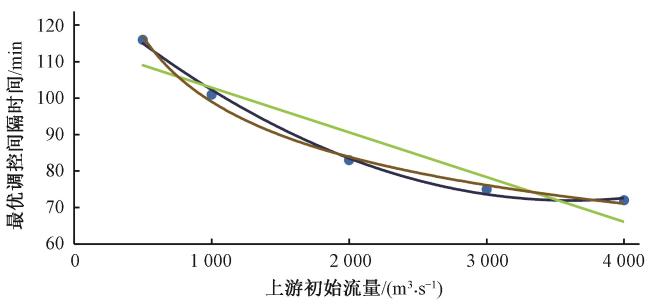 PDF(1808 KB)
PDF(1808 KB)


沙坪二级电站水力调控方法研究
李谷涵, 张召, 孔令仲, 雷晓辉, 王艺霖, 颜培儒, 许珂
 PDF(1808 KB)
PDF(1808 KB)
沙坪二级电站水力调控方法研究
Research on the Hydraulic Control Method of Shaping II Hydropower Station
我国现阶段水利工程群的调控以人工经验为主,因缺乏对水流时滞性的科学分析,难以满足新时期智能调控的迫切需求。枕头坝一级~沙坪二级区间位于大渡河流域,坡度陡,水力调控研究难度大,目前主要依靠人工经验开展水力调控方案的制定。以该区域为例,利用一维非恒定流数值模拟模型,对水流时滞性进行了系统分析,计算上游流量变化、下游水位稳定时下游边界的理想流量过程,提出了一种计算快捷、操作可靠的水力调控方法,经水动力模拟验证,该调控方法产生的最大水位波动在0.2 m左右,能够保证河渠的安全。最后基于该调控方法以及敏感性分析,构建了能够快速生成沙坪二级电站不同情景下的水力调控方案的公式。
At this stage, China’s water conservancy engineering group is still based on manual experience. Due to the lack of scientific analysis of the time lag of water flow, it is difficult to meet the urgent needs of intelligent regulation in the new era. The Zhentouba I~Shaping II section is located in the Dadu River Basin, with steep slopes and difficult hydraulic control research. At present, the hydraulic control plan is mainly based on manual experience. Taking this area as an example, this paper uses a one-dimensional unsteady flow numerical simulation model to systematically analyze the time lag of water flow, calculate the ideal flow process of the downstream boundary when the upstream flow changes and the downstream water level is stable, and a fast calculation method is proposed. The reliable hydraulic control method has been verified by hydrodynamic simulation, and the maximum water level fluctuation produced by the control method is about 0.2 m, which can ensure the safety of the river canal. Finally, based on the control method and the orthogonal test method of sensitivity analysis, a formula that can quickly generate the hydraulic control plan under different scenarios of the Shaping II Hydropower Station is constructed.
水力调控 / 水动力数值模拟 / 正交试验 {{custom_keyword}} /
hydraulic control / hydrodynamic numerical simulation / orthogonal test {{custom_keyword}} /
表1 最优调控间隔时间因素水平表Tab.1 The level table of the optimal regulation interval time factor |
| 水平 | 因素 | ||
|---|---|---|---|
| 上游初始流量/(m³·s-1) | 下游水位/m | 流量变化量/% | |
| 水平1 | 1 000 | 552 | -10 |
| 水平2 | 2 000 | 553 | -20 |
| 水平3 | 3 000 | 554 | -30 |
表2 最优调控间隔时间正交试验表Tab.2 Orthogonal experimental table of optimal control interval time |
| 试验号 | 因素 | 试验结果 | ||
|---|---|---|---|---|
| A | B | C | ||
| 上游初始流量/(m³·s-1) | 下游水位/m | 流量变化量/% | 最优调控间隔时间/min | |
| 1 | 1 000 | 552 | -10 | 95 |
| 2 | 1 000 | 553 | -20 | 95 |
| 3 | 1 000 | 554 | -30 | 96 |
| 4 | 2 000 | 552 | -30 | 87 |
| 5 | 2 000 | 553 | -10 | 85 |
| 6 | 2 000 | 554 | -20 | 84 |
| 7 | 3 000 | 552 | -20 | 80 |
| 8 | 3 000 | 553 | -30 | 79 |
| 9 | 3 000 | 554 | -10 | 75 |
表3 各影响因素不同水平作用下极差分析结果Tab.3 Results of range analysis under different levels of influence factors |
| 项目 | 上游初始流量/(m³/s) | 下游水位/m | 流量变化量/% |
|---|---|---|---|
| K 1 | 95.33 | 87.33 | 85.00 |
| K 2 | 85.33 | 86.33 | 86.33 |
| K 3 | 78.00 | 85.00 | 87.33 |
| k 1 | 31.78 | 29.11 | 28.33 |
| k 2 | 28.44 | 28.78 | 28.78 |
| k 3 | 26.00 | 28.33 | 29.11 |
| Rj | 5.78 | 0.78 | 0.78 |

图4 最优调控间隔时间与上游初始流量拟合结果Fig.4 Fitting results of optimal regulation interval time and upstream initial flow |
| 1 |
王 浩,王建华. 中国水资源与可持续发展[J]. 中国科学院院刊,2012,27(3):352-358,331.
{{custom_citation.content}}
{{custom_citation.annotation}}
|
| 2 |
王 浩,贾仰文. 变化中的流域“自然-社会”二元水循环理论与研究方法[J]. 水利学报,2016,47(10):1 219-1 226.
{{custom_citation.content}}
{{custom_citation.annotation}}
|
| 3 |
王 浩,雷晓辉,尚毅梓. 南水北调中线工程智能调控与应急调度关键技术[J]. 南水北调与水利科技,2017,15(2):1-8.
{{custom_citation.content}}
{{custom_citation.annotation}}
|
| 4 |
孔令仲. 大型明渠输水工程常态控制与应急调控算法研究[D]. 杭州:浙江大学,2019.
{{custom_citation.content}}
{{custom_citation.annotation}}
|
| 5 |
{{custom_citation.content}}
{{custom_citation.annotation}}
|
| 6 |
{{custom_citation.content}}
{{custom_citation.annotation}}
|
| 7 |
{{custom_citation.content}}
{{custom_citation.annotation}}
|
| 8 |
邱训平,杨丽莉. 地表水水量和水质的联合实时控制[J]. 水利水电快报,2012,33(11):1-5.
{{custom_citation.content}}
{{custom_citation.annotation}}
|
| 9 |
{{custom_citation.content}}
{{custom_citation.annotation}}
|
| 10 |
孔令仲,王 浩,雷晓辉,等. 基于线性预测控制算法的明渠实时控制研究[J]. 水利学报,2020,51(3):326-334.
{{custom_citation.content}}
{{custom_citation.annotation}}
|
| 11 |
杨 迁,孔令仲,宋培兵,等. 耦合前馈控制策略的明渠线性最优控制方法[J]. 水力发电学报,2020,39(5):64-71.
{{custom_citation.content}}
{{custom_citation.annotation}}
|
| 12 |
崔 巍,王长德. 调水工程运行最优控制研究[J]. 南水北调与水利科技,2007(2):6-8,24.
{{custom_citation.content}}
{{custom_citation.annotation}}
|
| 13 |
王长德,张礼卫. 下游常水位水力自动控制渠道运行动态过程及数学模型的研究[J]. 水利学报,1997(11):12-20,71.
{{custom_citation.content}}
{{custom_citation.annotation}}
|
| 14 |
{{custom_citation.content}}
{{custom_citation.annotation}}
|
| 15 |
熊 玺,周林勇. 混凝土缺陷水下修复技术在枕头坝一级水电站的应用[J]. 水电与新能源,2018,32(04):56-58.
{{custom_citation.content}}
{{custom_citation.annotation}}
|
| 16 |
涂承义,黄 维,吴宏荣,等. 沙坪二级水电站预应力闸墩设计及三维有限元分析[J]. 人民长江,2019,50():108-113,134.
增刊2
{{custom_citation.content}}
{{custom_citation.annotation}}
|
| 17 |
麦赫默德,叶夫耶维奇. 明渠不恒定流 [M] . 北京:水利电力出版社, 1987.
{{custom_citation.content}}
{{custom_citation.annotation}}
|
| 18 |
NEWTON. Mathematical principles of natural philosophy and his system of the world[M]. University of California Press, 1962.
{{custom_citation.content}}
{{custom_citation.annotation}}
|
| 19 |
{{custom_citation.content}}
{{custom_citation.annotation}}
|
| 20 |
{{custom_citation.content}}
{{custom_citation.annotation}}
|
| 21 |
王船海,李光炽,向小华,等. 实用河网水流计算[M]. 河海大学出版社,2015.
{{custom_citation.content}}
{{custom_citation.annotation}}
|
| 22 |
刘瑞江,张业旺,闻崇炜,等. 正交试验设计和分析方法研究[J]. 实验技术与管理,2010,27(9):52-55.
{{custom_citation.content}}
{{custom_citation.annotation}}
|
| 23 |
李凡琦,牧振伟,孙德旭,等. 基于正交设计的糙条消能工评价方法[J]. 排灌机械工程学报,2020,38(5):481-487.
{{custom_citation.content}}
{{custom_citation.annotation}}
|
| 24 |
方开泰,马长兴. 正交与均匀试验设计[M]. 北京:科学出版社,2001.
{{custom_citation.content}}
{{custom_citation.annotation}}
|
| 25 |
张旭辉,龚晓南,徐日庆. 边坡稳定影响因素敏感性的正交法计算分析[J]. 中国公路学报,2003(1):37-40.
{{custom_citation.content}}
{{custom_citation.annotation}}
|
| 26 |
何晓群. 现代统计分析方法与应用[M]. 北京:中国人民大学出版社, 1998.
{{custom_citation.content}}
{{custom_citation.annotation}}
|
| 27 |
梅长林. 数据分析方法[M]. 北京:高等教育出版社,2006.
{{custom_citation.content}}
{{custom_citation.annotation}}
|
| {{custom_ref.label}} |
{{custom_citation.content}}
{{custom_citation.annotation}}
|
 PDF(1808 KB)
PDF(1808 KB)
/
| 〈 |
|
〉 |